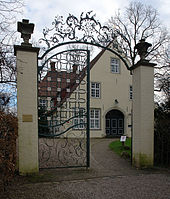Gut Wolfskuhle
The Wolfskuhle estate was a property located on Kattenturmer Heerstraße (roughly at the height of today's no. 141) in the Obervieland district of Bremen , which has probably been owned by Bremen bourgeois families since its beginnings, at the latest in the 18th century.
history
Since coat of arms stones with the date 1574 were found during construction work on the site, which is far outside the historical town development, it is assumed that a Bremen man's estate was here as early as the 16th century. Around 1760 it belonged to the Bremen merchant Johann Abraham Retberg, from 1772 to the family of Nikolaus Meyer , who was born here in 1775 and a friend of Johann Wolfgang von Goethe . In 1836 the name "Gut Wolfskuhle" was first recorded. Various owners followed: Heinrich Diedrich Alberti in 1813, Johann Friedrich Schlingmann in 1825, Andreas Heinrich Knoop built a new manor house in 1849, Georg Johann Schweers bought it in 1869, and in 1905 the Henriette Schweers Knoop Foundation came into possession, which until 1923 was an “idiot institution “And took in a convalescent home for tuberculosis sufferers and in 1925 became a transit home for homeless and unemployed women. Photos from the 19th century reveal the shape of the main building, which has not been preserved: a simple, gable-facing house with six window axes and a gable roof . Part of the property was converted into a public park in 1933. Today, between Wolfskuhlenweg and Schweersweg, next to Wolfskuhlenpark there is a retirement home and the kidney center Bremen-Süd.
French Gate
The Wolfskuhle estate is particularly well-known in Bremen because the Franzosentor originally stood here at the end of the street , a blacksmith's work made around 1760, which was transferred to the Historical Museum in 1913 and which today provides access to Haus Riensberg . The gate is registered in the monument database of the Bremen State Office for Monument Preservation as part of the Haus Riensberg cultural monument .
Surname
As Wolfskuhlen one called pit-like traps for wolves. According to Buchenau, the “Wolfskuhle” pond, which still exists in the park between Wolfskuhlenweg and Schweersweg, was the remainder of a brake (a scouring caused by a dike breach) that had been dammed since 1853.
Individual evidence
- ↑ Buchenau, p. 248
- ↑ On this: Johann Abraham Retberg's travel diary, in: Journal of the Central Office for Lower Saxony Family History, Vol. 8, 1926, pp. 204–206.
- ^ Heinrich Smidt : Wiegen songs, nurse rhymes and nursery jokes in Low German dialect, Bremen 1859.
- ^ Monument database of the LfD
literature
- Franz Buchenau : The Free Hanseatic City of Bremen , Bremen 1934, p. 248.
- Gustav Brandes: From the gardens of an old Hanseatic city , Bremen 1939, p. 116.
- Rudolf Stein : Classicism and Romanticism in the Architecture of Bremen , Volume 2, 1965, pp. 338–341 (photo from 1896).
- Herbert Schwarzwälder : Das Große Bremer Lexikon , Bremen 2002, p. 819.
Coordinates: 53 ° 2 ′ 30.8 ″ N , 8 ° 48 ′ 53 ″ E

